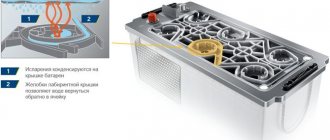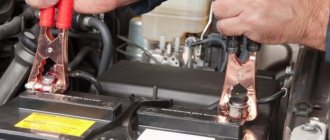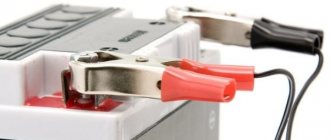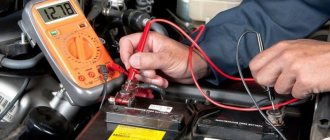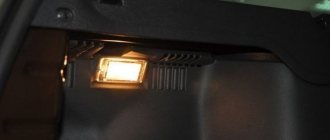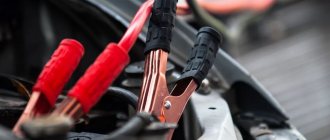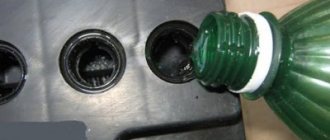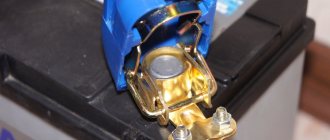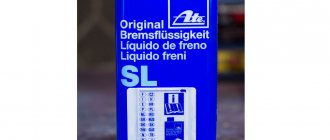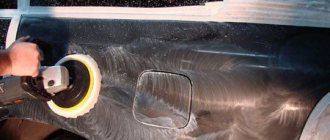A rechargeable battery, like any other device, has a certain service life, depending on several factors. Some car enthusiasts find the process of caring for the device burdensome and do not do it at all, which leads to premature battery failure. But in vain, because if you follow simple recommendations, the service life of the device can be increased from three to five years and, as a result, significantly reduce your costs. We will tell you how to properly service a car battery with your own hands in this article.
Factors affecting battery life
To understand what you should focus on when performing preventive work, you should know about the processes and factors that negatively affect the device. These include:
Average state of charge
Ideally, the battery in the car should always be fully charged, that is, the capacity lost during idle time should be replenished from the generator while the engine is running. However, with a large number of consumers (headlights, radio, air conditioning, TV), as well as with frequent engine starts, the generator simply does not have time to replenish the lost charge. In addition, low temperatures also contribute to faster loss of capacity (more on this below). As a result of these factors, the battery is constantly in an undercharged state, and the lower the average state of charge, the less the battery “lives”. It is for this reason that it is necessary to periodically recharge the battery using an AC charger, or, as it is popularly called, “charging”.
Temperature at which the battery is operated
Ambient temperature greatly affects the technical characteristics of the battery. For example, the battery produces its nominal capacity only at temperatures above twenty degrees. Its decrease by one degree leads to a drop in capacity by 1 Ah. This leads to difficulties when starting the engine in winter. In addition, if the battery is completely discharged due to low temperature, the electrolyte in it may freeze, which will result in failure of the device.
On the other hand, high temperature leads to boiling of the electrolyte, due to which water begins to quickly evaporate from the composition. And this entails a drop in the liquid level, which subsequently results in oxidation of the plates. To avoid this, it is necessary to periodically check the electrolyte level.
On-board network status
The operation of the battery is also affected by the condition of the vehicle’s on-board network, namely: the contact connection of the modules, the quality of the wiring, and the number of consumers. But the most important elements are the generator and voltage regulator. If they work poorly, the battery will have to be changed very soon. At high voltage supplied to the battery, the electrolyte will constantly boil, and at low voltage, the device will discharge. The negative consequences of these factors were written above.
on “Care and maintenance of car batteries”
- Gosha:
You underestimate our brother. Craftsmen have long learned to extend the life of batteries and turn maintenance-free batteries into serviceable ones. To do this, you need to take: - an awl or a small drill with a thin nozzle - a syringe, preferably a long one, which is mainly used by diabetics - distilled water - a ruler. Next, knowing that the inside of the battery consists of plates between which there is electrolyte, remove the sticker, cover or whatever is on top, visually divide the surface of the battery into an even number of parts, mark them with a marker. Then we begin to make a hole above each jar with an awl or a drill, after which we insert the syringe, tighten the rod a little and watch when liquid begins to fill into it, roughly determine its level and measure it with a ruler, after which we mark the height of the electrolyte on the side of the battery. Then, using the same syringe, we begin to add 3-5 ml of distilled water and so on for several approaches, after which we look at the indicator, which should have changed its color to green (usually so). Next, we check what happened by turning on the ignition.Answer
- Semyon:
There are a number of other measures, not described in the article, that can extend the life of the battery. The battery must be well secured to the vehicle. Excess vibration only causes harm. It is recommended to make a foam rubber backing and place it under the battery. It will serve as a shock absorber. Every 15,000 km, it is necessary to clean the terminals with fine-grained sandpaper. Clean terminals should be lubricated with technical Vaseline. The ventilation holes for removing gases must be clean, as well as the entire surface of the battery. If the car is not used in winter, the battery should be placed in a warm room. Do not allow the battery to completely discharge. Overcharging the battery, which is possible when the voltage regulator relay fails, is also harmful. The voltage generated by a car generator should not exceed 14V. And lastly, initially buy batteries from a reliable manufacturer. There are a lot of fakes on sale now, so you need to be careful.
Answer
Corrosion processes
Unfortunately, it is not possible to completely stop the corrosion process. Manufacturers only slow it down with the help of special additives. In this situation, motorists can be advised to use high-quality consumables (electrolyte and distilled water). By the way, we recommend buying the latter at a pharmacy and not at an auto parts store, since in this case there is a high probability of running into tap water. However, you can check its quality yourself. To do this, you need to create an electrical circuit from a battery, several wires and a light bulb. The conductor in the circuit must be water. Connect the wires to the battery and lower it into the water. We do the same with the light bulb and another pair of wires. If the light is on, it means there are a lot of different salts in the water, therefore it is not a distillate.
If you have the appropriate skills and knowledge, you can make your own electrolyte by mixing sulfuric acid and distilled water in the required proportions.
Important! Sulfuric acid is an aggressive substance that negatively affects the skin, mucous membrane and other soft tissues. When working with it, do not forget to use personal protective equipment.
Short circuit and housing damage
This can occur when separators are destroyed or electrolyte particles settle in battery banks. Other causes of short circuits include:
- excessive shaking of the battery due to insufficient fixation of the device in the engine compartment;
- use of high-density electrolyte;
- plate deformation due to excessively high current;
- Charging takes too long.
We recommend: Which battery is better: serviced or maintenance-free
It is possible to repair a car battery with such damage only if the battery model is serviceable. Maintenance-free models will have to be thrown away immediately after a short circuit.
If the surface of the battery is damaged, repairs can be performed, but it all depends on the level of damage. In most cases, the problem can be solved with a good glue.
Before use, remove all electrolyte from the battery and thoroughly dry the reservoir. After repair, a new electrolyte mixture is poured into the battery.
Diagnostic procedures
This group includes:
- Checking the voltage level in the vehicle's on-board network.
- Checking the voltage level of the disconnected battery.
- External inspection of the device.
- Electrolyte level monitoring.
The voltage level can be measured using the car's standard electronics (most on-board computers have this function) or using a multimeter. Note that standard means can only measure the voltage of the connected battery. To check with a multimeter, you simply need to switch the device to voltage measurement mode up to 20V, and then connect the device probes to the corresponding battery terminals. Normal voltage readings when the battery is disconnected are 12.9V, and when connected – 14.2V. If there are serious differences in readings (more than 1V), the battery being serviced should be charged.
An external inspection of the device will reveal leaks of electrolyte and electric current. To eliminate smudges, use a soda solution, which neutralizes the electrolyte.
The electrolyte level can be measured with a measuring tube. Open the jar of liquid and lower the measuring tube into it. Then pinch its upper end with your finger and pull it out. The normal level is in the range of 10-15mm. It is corrected using distilled water.
It is recommended that you service your vehicle's battery while performing other diagnostic work, such as checking the oil level.
Maintenance free battery
When deciding how to service a maintenance-free battery, you should pay attention to the manufacturer's instructions. Many car enthusiasts prefer this type of equipment, since its routine maintenance is very simple.
In this case, you first need to inspect the battery case. There should be no leaks in it. Next, you should inspect the drainage holes. If contamination is detected, they must be cleaned. All other battery parts also require similar steps.
If an electrolyte leak is detected, it must be promptly eliminated and the acid neutralized. For this, use regular soda. If the device has a built-in hydrometer, it is necessary to check the density of the liquid inside the housing.
Next, the contacts are lubricated. This will protect them from destruction. It is also necessary to periodically check the voltage at the terminals of the device while the car engine is running.
Service procedures
This group includes:
- Check and, if necessary, adjust the density of the electrolyte.
- Testing battery performance under load.
- Charging the battery using a charger.
- Checking current leakage.
- Measures to slow down sulfation.
Electrolyte density is measured using a hydrometer. You need to open the jar of liquid and take it using the “pear” included with the device. After the float or sticks float, look at the readings. For a charged battery, the normal result is a density of 1.22 to 1.29, depending on temperature and state of charge. The density is adjusted by adding distilled water, or by filling the battery with new electrolyte. The density is checked for each can separately.
Measuring electrolyte density with a hydrometer
Load testing of the battery is carried out using a load fork, which simulates the operation of the starter. Just as in the case of a multimeter, you should connect a load plug to the battery, run the test and compare the readings.
Note! You should not load the battery for more than five seconds - this will lead to its failure. The normal value is considered to be 10.2V.
The battery is charged approximately every three months. For these purposes, you need to buy a charger (preferably an automatic one, as this will greatly simplify the process).
Current leakage should also be checked with a multimeter. It is necessary to connect the red probe to the positive, and move the black probe to the places where smudges appear. If readings appear on the device, it means that the battery should be urgently taken to service.
Slowing down the sulfation of a new battery involves conducting a control and training cycle, during which the battery must be charged and discharged several times. However, keep in mind that a calcium battery is extremely sensitive to complete discharge. Its discharge cycle can be carried out using a special device, or by turning on a light bulb.
How to service a car battery yourself?
Checking battery voltage
Everything is simple here and to measure the voltage you only need a multimeter or voltmeter. The battery can be removed from the vehicle or simply disconnected the terminals. The multimeter is switched to voltage measurement mode, the probes are thrown onto the battery terminals (red for plus, black for minus). Nothing bad will happen if the probes are connected in reverse. The voltage will just be negative.
Measuring battery voltage with a multimeter
The voltage value on a charged battery should be in the range of 12.6-12.9 volts. If it drops below 12 volts, then you need to charge the battery. It is strictly not recommended to operate it in this condition. This significantly increases sulfation and shortens service life. For calcium batteries, strong discharges are completely contraindicated, since after this they irreversibly lose capacity. Read more about car battery voltage at the link provided.
Checking the voltage in the on-board network
Here, measurements are also carried out with a multimeter on the battery terminals, but the battery is installed on the car and the engine is running. At the same time, turn on the heated rear window, heater and radio to simulate real operating conditions. The voltage value should be in the range of 13-14.4 volts.
If the voltage is less, the battery simply will not charge, and if it is more, there will be a high water consumption. If the voltage does not comply with the specified limits, you should contact an auto electrician to check the operation of the generator, voltage regulator and other components of the vehicle's electrical network. Read more about this in the article “The car battery does not charge from the generator.”
Checking the electrolyte level
Diagnostics of a car battery includes checking the electrolyte level, which you can do without removing the battery from the car. To do this, you need to unscrew the plugs in the battery jars or remove the entire lid if it is solid. Use a glass tube to measure. If you don’t have one, you can use the body of a simple ballpoint pen.
Handle body
Electrolyte collection in jars
Electrolyte level
Lower the tube into the jar until it touches the plates, close one end with your finger and lift it up.
The height of the electrolyte remaining in the tube should be 10-15 millimeters. And carry out such a check in every bank. If you don’t have a tube at hand, you can simply visually check the electrolyte level so that it covers the plates with a reserve.
When inspecting, use a flashlight to illuminate yourself.
Attention! Never use a lighter for illumination. When charging, hydrogen accumulates in the battery. If a spark gets into its mixture with oxygen, the car battery will explode. Remember this and follow safety precautions.
In maintenance-free car batteries, the electrolyte level can be checked by the marks on the case: min and max. He must be between them. Although in most cases such testing is not required for this type of battery.
Visual control
Visually inspect the battery for damage. In addition, the battery must be kept clean. Wipe off traces of oil, electrolyte, and dirt from the body. It is recommended to wipe the battery with a baking soda solution (1 teaspoon per glass of water). Soda neutralizes the electrolyte.
Battery condition is poor
If the battery is dirty and has electrolyte leaks, then a conductive film will always be present on the surface. Because of this, the self-discharge of the battery will increase. We recommend covering the terminals with anti-corrosion gels or sprays. They are available at any auto store and are inexpensive. It is easier to keep the battery clean and in working condition than to repair the car battery later.
Charging the battery with a network charger
Under normal operating conditions and regular car trips, charging is recommended once every three months. It would be more correct to call it recharging. That is, the battery charge is simply brought to the maximum, and periodic recharging is done on the go from the generator. This type of charging can be carried out at constant voltage in automatic mode. You can read more about different charging modes in the article “How to properly charge a car battery with a charger.”
Battery charging can be regular or unscheduled
There is also a need for unscheduled charging. For example, you forgot to turn off the headlights and the battery died. It may happen that the car has been parked for a long time and the battery has not been used. Then it is better to charge under control in constant current mode. This will allow it to return capacity after a deep discharge.
We also recommend reading about how to charge a calcium car battery.
Checking and adjusting the electrolyte density in the battery
The electrolyte density should be checked after the battery is fully charged. For batteries operated in the middle zone, the density of the electrolyte of a charged battery should be 1.27─1.29 g/cm3. In northern latitudes, the density can be increased to 1.3 g/cm3. To control the density, you will need a hydrometer, and to adjust it, distilled water or an electrolyte.
Hydrometer
Distilled water
Electrolyte
The electrolyte charge table is shown below. In it you can see the dependence of the battery charge level, density and freezing temperature of the electrolyte.
| Electrolyte density, g/cm. cube (+15 degrees Celsius) | Voltage, V (no load) | Voltage, V (with load 100 A) | Battery charge level, % | Electrolyte freezing temperature, gr. Celsius |
| Electrolyte density, g/cm. cube (+15 degrees Celsius) | Voltage, V (no load) | Voltage, V (with load 100 A) | Battery charge level, % | Electrolyte freezing temperature, gr. Celsius |
| 1,11 | 11,7 | 8,4 | 0 | -7 |
| 1,12 | 11,76 | 8,54 | 6 | -8 |
| 1,13 | 11,82 | 8,68 | 12,56 | -9 |
| 1,14 | 11,88 | 8,84 | 19 | -11 |
| 1,15 | 11,94 | 9 | 25 | -13 |
| 1,16 | 12 | 9,14 | 31 | -14 |
| 1,17 | 12,06 | 9,3 | 37,5 | -16 |
| 1,18 | 12,12 | 9,46 | 44 | -18 |
| 1,19 | 12,18 | 9,6 | 50 | -24 |
| 1,2 | 12,24 | 9,74 | 56 | -27 |
| 1,21 | 12,3 | 9,9 | 62,5 | -32 |
| 1,22 | 12,36 | 10,06 | 69 | -37 |
| 1,23 | 12,42 | 10,2 | 75 | -42 |
| 1,24 | 12,48 | 10,34 | 81 | -46 |
| 1,25 | 12,54 | 10,5 | 87,5 | -50 |
| 1,26 | 12,6 | 10,66 | 94 | -55 |
| 1,27 | 12,66 | 10,8 | 100 | -60 |
In case of water evaporation and density increase, you just need to add distilled water to the level. If the density is lower than required, then the task is more difficult. In this case, you need to select a low-density electrolyte and fill in a new one with a density of 1.28 g/cm3 instead. For more information on this topic, you can read the article “What acid is in a car battery and what is the electrolyte for?”
Battery test with load fork
The load fork allows you to reliably assess the condition of the battery. This device simulates the load on the battery created when starting a car engine. Therefore, it is useful to carry out such a check when servicing the battery yourself.
Checking a car battery with a load fork.
For more information about using a load fork, read the corresponding section of the article “How to check the performance of a car battery.”
Leakage current test
If the leakage current on the battery in the car network exceeds the norm, then this can create serious problems for the car owner. Even if the battery is fully operational, the leakage current will constantly drain it and prevent normal charge recovery.
Checking the leakage current of a car battery
To measure the leakage current, you will again need a multimeter. This time it should be set to current measurement mode. The process is described in detail in the article “Car battery leakage current: norm and measurement.”
Preventive desulfation work
It is worth noting here that in the case of neglected sulfation, it is practically impossible to achieve tangible results. Various desulfation methods work only in the case of the initial stage of sulfation of the plates. Therefore, it is important to carry out these activities periodically, without triggering sulfation.
The article “Battery Desulfation” provides a number of methods for dissolving lead sulfate. Among them, we can highlight the control-training cycle (CTC), in which several charge-discharge cycles are carried out. You can easily do this operation yourself by charging the battery and discharging it with some load (for example, a 12V light bulb) to a voltage of 10.8 volts.
It is worth noting that CTC is not recommended for calcium batteries. They are resistant to overcharging, but cannot withstand deep discharge. Now you know all the necessary information on car battery maintenance. If you have any questions, as well as corrections and additions, write them in the comments below. We will be happy to answer them.
Quick restoration of a dead battery
Before repairing the car's battery, it is necessary to examine it for other faults. If no damage is found, and the battery is dead only due to sulfation, then you can use the following method to restore it:
- To begin, the battery must be charged.
- The electrolyte must be drained and the battery cleaned with distilled water. It's better to do this several times.
- A special cleaning agent containing Trilon and ammonia must be poured into the tank. The substance should be left inside for 50-60 minutes.
- Then the liquid must be drained and the device rinsed again with clean water.
- After this, you need to fill in a new electrolyte composition and recharge the battery.
We recommend: Battery A Mega (A-Mega) for premium cars
Considering that the restoration of the device is carried out using aggressive substances, you need to put on rubber gloves in advance. If, in addition to replacing the electrolyte, you also need to replace other parts, then it is better to purchase a new device, because spending money on repairing old-style car batteries is completely impractical.
Car battery repair conditions
In order for a car battery to function properly, a couple of conditions must be met:
- Compliance with electrolytic density as specified by the manufacturer. It is important to take into account that the operation of the battery in different seasons implies different density indicators, which is important for seasonal maintenance of the car.
- Plate desulfation process. When a high current is briefly applied to the battery and then unloaded (by connecting a low-power electric current consumer), the lead sulfate contained in the plates peels off.
At the moment, modern charging technology helps to desulfate batteries at home. There are a few things you should know about charging.
The price of charging for home use is quite low. Residents of Moscow can buy it for almost half the price of the most inexpensive battery. Thus, all car lovers should buy this device; it will make it possible to maintain battery performance and prepare for seasonal changes. True, the charger is considered a complicated device in technical terms and repairing it yourself will be problematic if you are far from understanding the electrical component.
The basic model of the charger includes the following components:
- power transformer that provides the required voltage;
- a diode bridge that converts the alternating current emanating from the transformer into direct current;
- mode switch: some types of charger may be suitable for 12-volt batteries and, for example, 6-volt motorcycle batteries; charging operating modes are provided (“Automatic”, “Cyclic” and “Pre-start”);
- ammeter (will give readings of the current current value), can be a digital type with a liquid crystal display or an analog type - with arrows;
- a fuse that protects the device from short circuits.
